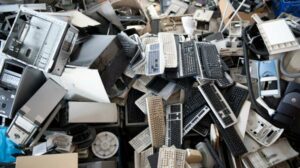10 facts about electronic recycling that you never knew
It is human nature to want the latest electronic gadgets as soon as they’re released to the public. Additionally, retailers incentivize their customers to upgrade their phones and devices frequently. On top of that, we are often drawn in by the prospect of the newest phone, tablet, or laptop making our lives that much easier with all of its new features.
But what about our old devices? More often than not, we either throw them away or place them in a drawer, wait a few months, and discard them when we have been unable to resell them. The trash generated by throwing away old electronics is referred to as “e-waste.” Unfortunately, this practice has had a serious impact on the environment and human health.

1. E-waste is toxic
Many of the devices that we throw away contain lead, cadmium, mercury, flame retardants, and beryllium. Due to improper disposal practices, these hazardous materials spill from the devices and leach into the ground. From this exposure, harmful chemicals contaminate groundwater and lead to both cancer and organ damage if consumed through taps.
2. E-waste accounts for 70% of toxic waste production
Electronic waste only takes up 2% of our landfills but accounts for 70% of our total toxic waste production. Despite these alarming numbers, only about 20% of the e-waste produced each year is recycled. This is a generous estimate as well, being that many sources claim that only 12-15% can be documented as recycled.
3. Recycling e-waste can save enough energy to power thousands of homes per year
While most people assume that recycling requires a lot of time and energy to produce results, proper recycling practices can actually save energy. If 1 million laptops were recycled instead of being thrown into landfills, enough energy would be saved to power approximately 3600 homes in the United States for a year.
4. E-waste is the world’s fastest-growing trash source
Each year, the number of electronic devices that go into landfills has increased. In 2016, there were almost 50 million tons of e-waste produced, and because of the steady increase of this waste type, it is estimated that 2021 will see more than 57 million tons of e-waste if practices do not improve.
5. Recycling e-waste can create jobs
While reusing and recycling electronic devices can save on energy consumption across the map, the task still requires people to perform labor and logistics. Because of this, e-waste recycling can be a significant economic benefit since producing 10,000 tons of recycled material can create as many as 300 new jobs.
6. The average user has their cell phone for under two years
It’s easy to understand why a new device is so appealing to users. The way that technology develops so quickly allows us to take advantage of new features that increase our productivity every year. However, most users only keep a cell phone for 18 months before they upgrade to a newer version, which aids in producing a great deal of e-waste.
7. Recycling e-waste reduces the waste of valuable raw materials
Many of the components in electronic devices are made with the use of various raw materials. Gold and silver are often used to make the inner workings of cell phones. Because of this, it’s estimated that the average landfill holds millions of dollars worth of gold and silver.
Recycling electronic waste could greatly reduce the need to constantly mine new materials for the creation of the latest devices.
8. The US discards hundreds of millions of electronic devices every year
The United States is the biggest producer of e-waste. Every year, US residents and businesses discard approximately 100 million cell phones, over 41 million computers, and over 20 million TV sets by throwing them into landfills when they become broken or outdated.
9. Several electronic retail stores accept e-waste for recycling
Lack of information might be one of the many reasons why consumers do not often recycle their old devices. When it’s difficult to determine where to take cell phones, computers, or TVs we usually decide to throw them in the trash assuming that there is no other destination for them.
Some electronic retail stores will accept your old devices and recycle them regardless of where you originally purchased the item. Verizon and Best Buy are among many recycling retailers, accept e-waste for recycling.





